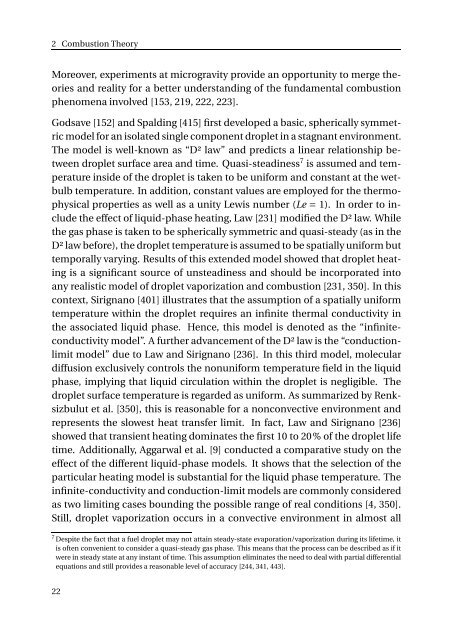On the Formation of Nitrogen Oxides During the Combustion of ...
On the Formation of Nitrogen Oxides During the Combustion of ...
On the Formation of Nitrogen Oxides During the Combustion of ...
You also want an ePaper? Increase the reach of your titles
YUMPU automatically turns print PDFs into web optimized ePapers that Google loves.
2 <strong>Combustion</strong> Theory<br />
Moreover, experiments at microgravity provide an opportunity to merge <strong>the</strong>ories<br />
and reality for a better understanding <strong>of</strong> <strong>the</strong> fundamental combustion<br />
phenomena involved [153, 219, 222, 223].<br />
Godsave [152] and Spalding [415] first developed a basic, spherically symmetric<br />
model for an isolated single component droplet in a stagnant environment.<br />
The model is well-known as “D² law” and predicts a linear relationship between<br />
droplet surface area and time. Quasi-steadiness 7 is assumed and temperature<br />
inside <strong>of</strong> <strong>the</strong> droplet is taken to be uniform and constant at <strong>the</strong> wetbulb<br />
temperature. In addition, constant values are employed for <strong>the</strong> <strong>the</strong>rmophysical<br />
properties as well as a unity Lewis number (Le = 1). In order to include<br />
<strong>the</strong> effect <strong>of</strong> liquid-phase heating, Law [231] modified <strong>the</strong> D² law. While<br />
<strong>the</strong> gas phase is taken to be spherically symmetric and quasi-steady (as in <strong>the</strong><br />
D² law before), <strong>the</strong> droplet temperature is assumed to be spatially uniform but<br />
temporally varying. Results <strong>of</strong> this extended model showed that droplet heating<br />
is a significant source <strong>of</strong> unsteadiness and should be incorporated into<br />
any realistic model <strong>of</strong> droplet vaporization and combustion [231, 350]. In this<br />
context, Sirignano [401] illustrates that <strong>the</strong> assumption <strong>of</strong> a spatially uniform<br />
temperature within <strong>the</strong> droplet requires an infinite <strong>the</strong>rmal conductivity in<br />
<strong>the</strong> associated liquid phase. Hence, this model is denoted as <strong>the</strong> “infiniteconductivity<br />
model”. A fur<strong>the</strong>r advancement <strong>of</strong> <strong>the</strong> D² law is <strong>the</strong> “conductionlimit<br />
model” due to Law and Sirignano [236]. In this third model, molecular<br />
diffusion exclusively controls <strong>the</strong> nonuniform temperature field in <strong>the</strong> liquid<br />
phase, implying that liquid circulation within <strong>the</strong> droplet is negligible. The<br />
droplet surface temperature is regarded as uniform. As summarized by Renksizbulut<br />
et al. [350], this is reasonable for a nonconvective environment and<br />
represents <strong>the</strong> slowest heat transfer limit. In fact, Law and Sirignano [236]<br />
showed that transient heating dominates <strong>the</strong> first 10 to 20% <strong>of</strong> <strong>the</strong> droplet life<br />
time. Additionally, Aggarwal et al. [9] conducted a comparative study on <strong>the</strong><br />
effect <strong>of</strong> <strong>the</strong> different liquid-phase models. It shows that <strong>the</strong> selection <strong>of</strong> <strong>the</strong><br />
particular heating model is substantial for <strong>the</strong> liquid phase temperature. The<br />
infinite-conductivity and conduction-limit models are commonly considered<br />
as two limiting cases bounding <strong>the</strong> possible range <strong>of</strong> real conditions [4, 350].<br />
Still, droplet vaporization occurs in a convective environment in almost all<br />
7 Despite <strong>the</strong> fact that a fuel droplet may not attain steady-state evaporation/vaporization during its lifetime, it<br />
is <strong>of</strong>ten convenient to consider a quasi-steady gas phase. This means that <strong>the</strong> process can be described as if it<br />
were in steady state at any instant <strong>of</strong> time. This assumption eliminates <strong>the</strong> need to deal with partial differential<br />
equations and still provides a reasonable level <strong>of</strong> accuracy [244, 341, 443].<br />
22
















